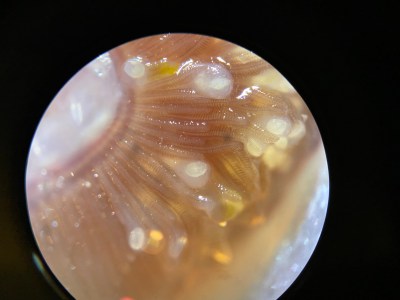Propagation innovations at the FWWIC Mussel Hatchery

The Fairmount Waterworks Interpretive Center’s Mussel Hatchery recorded another “first” in the science of freshwater mussel propagation. A living science laboratory, the goal of the FWWIC Demonstration Hatchery is to support freshwater mussel production and future wide-scale use of mussels to improve the health of the watershed. Freshwater mussels are incredible natural filtration systems, with just a single bivalve capable of filtering up to 300 gallons of water each month.
According to PWD Office of Watersheds Senior Scientist Lance Butler, “We’ve been under the assumption that Alewife Floaters, a hallmark species in the tidal Delaware River, were only able to successfully metamorphose and survive through their unique parasitic relationship with American Shad and other River Herring, such as Blueback Herring and Alewife. As such, we have been collecting land-locked Alewife fish at Blue Marsh Reservoir and transporting them to the hatchery for propagation. Live collection is a time-consuming effort with a potential of high fish mortality (ca. 15%-50%) due to the sensitive nature of this particular host species.”
On April 20th, scientists from Philadelphia Water Dept. and Partnership for the Delaware Estuary successfully inoculated and experienced excystment (metamorphosis of glochidia into a juvenile mussel) using hybrid striped bass (Striped Bass x White Bass) instead of the primary fish hosts previously used, yielding numbers far greater per fish. “The excysted juveniles appear to be very active, extremely healthy, and we’ve collected over 12,000 healthy transformed Alewife Floaters, or approximately 200 juveniles per host fish!” Butler added, “Efficiencies, safety, costs, and overall production appear to favor this host fish in many ways.”
“The Mussel Hatchery and lab is truly a living exhibit that constantly improves with new research and innovation. This kind of development is just what we had hoped for when we opened the hatchery in 2016,” added Executive Director of the Fairmount Water Works Interpretive Center Karen Young. “Complementary education and outreach we are conducting includes the development of environmental curriculum focusing on the benefits of mussel restoration, their potential to clean our waterways, and serve as indicators of aquatic health.”
Milestones to date include:
- 600+ students from six Philadelphia regional schools have actively participated in the Mussels In The Field program, whereby students are educated on field monitoring techniques and data.
- Piloted the successful Mussels in the Classroom program with Roxborough’s Lankenau High School whereby students learn the skills of culturing, ecology and life histories of native freshwater mussels.
- Collaborate with the Audubon Discovery Center on Mussel Maniacs community science program to engage local communities and students with real-world techniques to monitor freshwater mussel health.

The Mussel Hatchery at the Fairmount Water Works is thriving!
Here is the life cycle of a freshwater mussel in our hatchery in 8 steps:
- Female Alewife Floater releases glochidia
- Inoculation of Alewife fish with glochidia
- Glochidia attach to Alewife fish
- Placement of inoculated Alewife in Habitat units
- Encystmentof Alewife glochidia on Alewife fish gill
- Metamorphosis into juvenile mussel and excystment
- Placement of juveniles in buckets for feeding
- Alewife Floaters released back into the wild
Mussel Hatchery at the Fairmount Water Works highlights:
- Successfully transformed 3,000 Alewife Floaters using Land-locked Alewife. (first known)
- Successfully transformed Alewife Floaters and Tidewater Mucket (State Endangered) at FWWIC. (first)
- Between 2023-2024, successfully transformed over 20,000 Eastern Pondmussels using Largemouth Bass. (first)
- Successfully transformed over 6,000 Eastern Elliptio juvenile mussels using Brook Trout. first)
- Successfully transformed Tidewater Mucket using an in vitro technique that bypasses fish inoculation. (first)
- Working with STEM students and college interns to fabricate a transparent Barnhart Bucket (laboratory feeding apparatus for juveniles) to be used (and replicated) in school science classes. (first)
- Successfully inoculated and experienced excystment using hybrid striped bass (Striped Bass x White Bass). Over 12,000 juveniles were produced using 60 fish. That’s approximately 200 juveniles per fish… more than their primary host fish!
- In 2024, performed our first physiological rate processing study to determine the pollutant removal facilitated by two species of freshwater mussels. Results will be used to determine the application of bivalve-mediated pollution removal as a complimentary approach to traditional pollution control technologies. (first)
- One more species to try (Yellow Lampmussel x Yellow Perch) – if successful, 5 for 5 in our laboratory!
- More than doubled our yearly propagation numbers in 2024 in just two inoculation trials. We still have six more trials to go!
